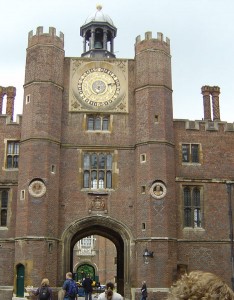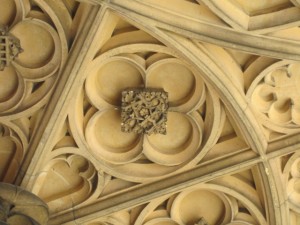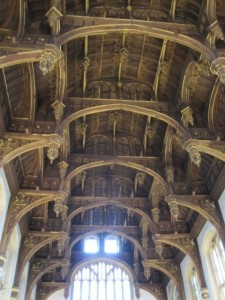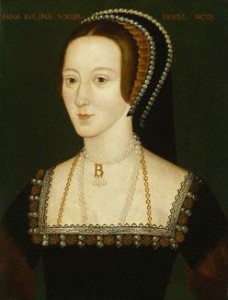Day 2
Absolutely fantastic!
Hmm, not enough for a report eh? Ok, let’s break it down then.
Situated on the banks of the Thames River about a 30 minute train ride from London, Hampton Court is the epitome of wealth, majesty and power.
The name is derived from two old Saxon words: “hamm” meaning “bend in a stream” and “ton” meaning “settlement”. Its origins nearly date to that time as well.
Before Cardinal Wolsey began working on his private home in 1514, the site was occupied by, among other things, a church run by the Knights Hospitaller. Wolsey had risen to power under the young Henry VIII by helping the King solve his most pressing political issues (ie. the path of the seals which limited the king’s ability to make autonomous decisions). With his rise came a substantial income that was funneled towards a new building project. In his time, Wolsey had completed the Great Gate House that was actually five stories in height rather than the present day three.
Upon entering the Base Court (thus named because the French derivative means first/ lower) turn right to see what was once his apartments. One of the rooms, the Wolsey Closet, contains some of the finest Tudor ceiling work as well as folded wood style wall panelling. On the other side of his apartments were 2-3 shallow fish ponds which were renowned for their fresh tasting stock. Anne Boleyn at one point even mentions how she’d fancy some prawn from the waters.
Wolsey’s biggest contribution to today’s palace is the chapel. How iconic is the chapel? Well, the Historic Royal Palaces uses the ceiling’s star imagery and color to represent Hampton Court in all it’s publication material. It was he who had the famous carved ceiling installed. Unfortunately, the great east window of stained glass has since been removed and replaced by a large wood carving. This change was due to later building additions blocking out the sun (among other things). The color and design currently herald from the Victorian era. A picture of the chapel as it looked in Tudor times can be found on page 25 of “Hampton Court Palace: The Official Illustrated History”.
In 1528 – 1529, Wolsey gave the palace to Henry as a way to appease the King who was swiftly tiring of his minister’s inability to obtain an annulment of his marriage to Katherine of Aragon. Despite his ongoing legal affairs and public discontent of his new mistress Anne, Henry spent the majority of his time with her.
To paraphrase Cardinal Campeggio: ” Even an angel descending from heaven would be unable to tell him otherwise”. Why is this relevant?
From 1530 to 1536, Anne had a major influence on construction at the palace. With Anne by his side, the king added new apartments for both of them (now the site of William and Mary’s own baroque housings…boo!) as well as establishing the great tennis court and, most importantly, the great hall. It is here you will find the last, forgotten vestiges of Anne’s reign as queen.
To enter the great hall, one must climb up a series of steps. This starts at the foot of the Clock Tower which transitions from the Base Court to the Clock Court. If you are under the archway, look up to find Anne’s falcon badge transfixed upon a diamond carving. Her initials are entwined with Henry’s in lover’s knots as well. These were simply missed when Henry ordered all of the disgraced queen’s insignia removed. Now, I have a bone to pick with the Victorians…yes, they did help renovate many historical treasures for future generations to see, but they absolutely loved to cover things in gold and replace actual artifacts with copies. They did it to the leering heads in the Temple Church and they did it with Anne’s badges. They are Victorian copies circa 1882. I was happy to find out that several originals were kept and actually got to see one in the great hall as part of the current “6 wives” exhibition. That was one of my highlights for the day.
Right before entering the great hall, there is a room to the left that has Katherine’s pomegranates carved into the corners of the door archway. Although a little hard to discern, it is definitely there.
That was a fact that I did not know and I’m not sure if Dr. Thurley mentioned this in his book on the palace either.
Now then, the great hall. No matter how many times I’ve seen it, I am always amazed. It took workers 5 years, working day and night, to complete it. In fact it is the last time a royal great hall was ever built due to upkeep and heating costs! The carved hammer beam roof is an absolute treat and was once elegantly painted. The paint was stripped away in the 1800’s (Victorians!!!) but all the details remain. Anne’s falcon badge makes numerous appearances along the outside panelling of the hall. At the termination point of each beam running perpendicular to the hall is a carving of heraldic beasts and wording. Several of these locations have “H” and “A” again entwined in lover’s knots. Took forever to get good images, but I finally had two I was happy with. Be on the look out for those at the culmination of this progress. One final location to look for Anne’s symbols is in the wooden screen that you pass under when you enter. Amongst the Tudor rose and Beaufort portcullises, you can find “A” juxtaposed over “H”.
The place is the only location that saw the arrival of each queen. Jane’s initials can be seen on an authentic heraldic frieze located outside of the royal chapel. While most likely not in-situ, the coloration and design is authentic. Within the privy kitchen of Queen Elizabeth I, now a nice tea room, is a silver plate marked with features to denote it belonging to the Prince of Wales (future Edward the 6th). It was also stamped with the wheel of Cleves in reference to Henry’s fourth wife, Anne of Cleves. It is thought that they just recycled the dish by hastily adding a new stamp.
In the watching chamber, the fine Tudor ceiling which sadly is one of the only authentic pieces left in the room, contains mâché roundels of a Phoenix rising from a castle. This is a reference to Jane Seymour. Some original roundels and a stone carving of the queen’s badge can be found in the palace exhibition area.
Having walked the palace for five hours and not gotten thrown out by His Majesty who noticed my “Team Boleyn” shirt, I decided to head back to London. Before I went to the station, I went down a street slightly to the north east of Hampton Court. There I found the royal stables built by Elizabeth. Although not open to the public, they are still serving as stables to this day.
Back in London, I decided to walk to the National Portrait Gallery. For all those interested in Anne’s portrait, I can give you a small update. Her picture is still hanging in the gallery but with a note saying that “due to a successful fundraising effort, this portrait can now under-go renovations starting next month, I must say that it is wonderful to finally see all the paintings in person rather than on the pages of books. Even better, the gallery is free, but I gave them a good contribution by ordering a large reprint of Anne’s portrait, which they print on site. Now to find a suitable Tudor frame…
Thus ends day two… With more books and Tudor CDs than I need. Tomorrow it’s off to Hever Castle and then the Boleyn play at the Globe Theatre. Weather is looking bad which means the walk through the farmers fields to get to Hever will be a little muddy…good thing I brought my white walking shoes!
Cheers!
Click here to Mike’s photos taken at Hampton Court Palace.






















I stayed up late just to see this! Thanks again!!!
Good work my comrade, it is good to see others have the interest of mine.
As always very interesting and full of many good facts I did not know.
One of my favourite places in the world. Im so lucky living only 30 minutes from here. Just love it!
Hello: I was very happy when visiting this place…..